The Fundamentals of Roasted Calabaza Squash
I had honestly never cooked with calabaza squash before this. I'm sure that I've seen them around and overlooked something enormous that I didn't quite know what to do with! But I do enjoy picking up ingredients at random and just kind of winging it. There are so many delicious things out there that we have never tried before! And roasted calabaza squash was my endeavor today.
It most certainly did not disappoint! Roasted calabaza squash is my new favorite obsession. Plus, the squash weighed almost 10 pounds (9.55), so now I have pounds and pounds and pounds of squash purée to figure out what to do with! A most delectable dilemma.
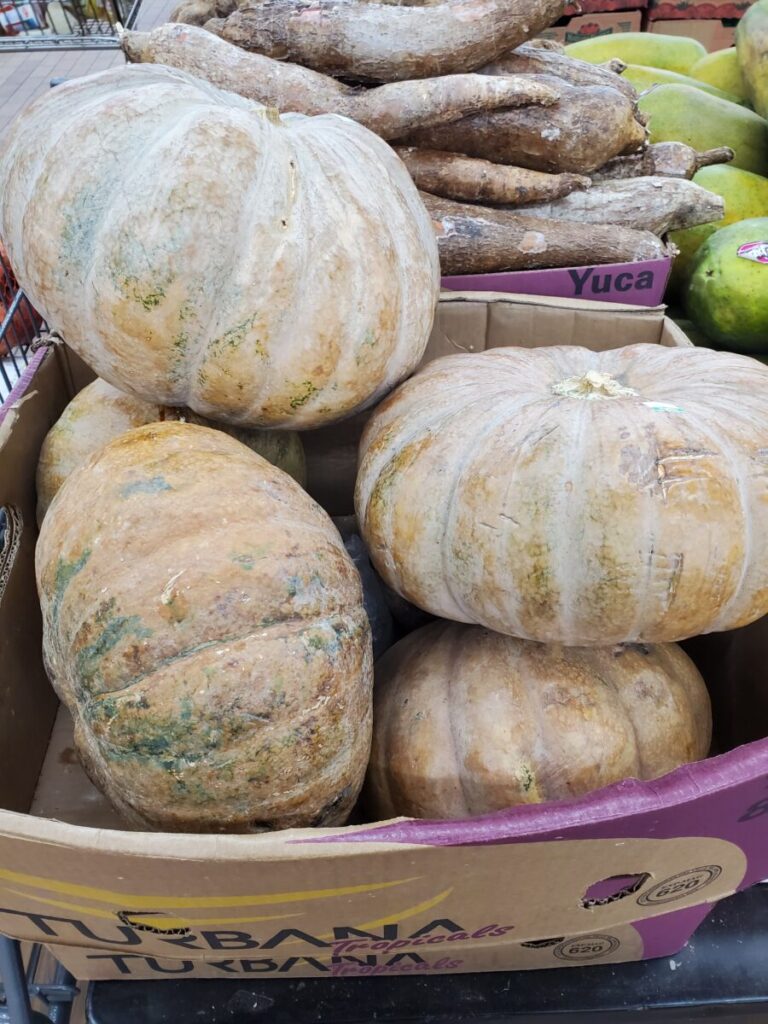
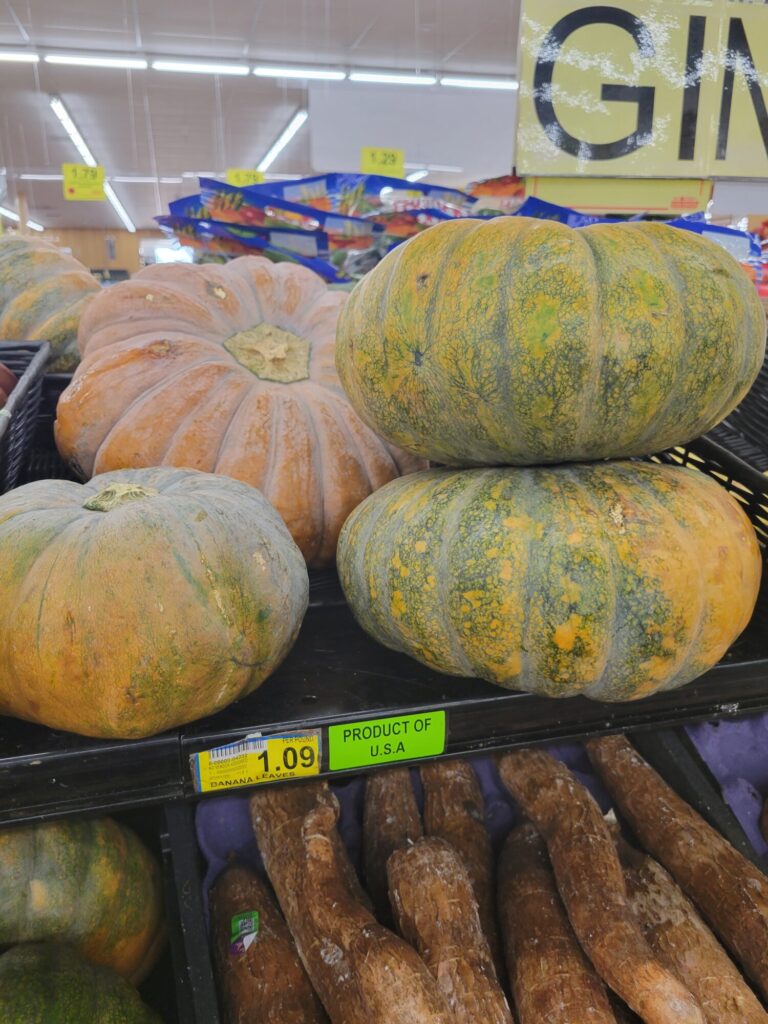
Where Do You Get Calabaza Squash?
I have been able to find calabaza fairly consistently at my favorite out of the way grocery store: Woodman's. Now, this is an employee owned grocery store. At first it might sound like some podunk independent grocer, but it really is a massive store that's probably almost the size of a Costco. It doesn't sell quite as much food in bulk (although there definitely is some) and there are no memberships. But it does cater to a large Asian and Latin American base and boasts a wide range of otherwise difficult to find produce, cheese, vegan and gluten free products, and the widest range of Gatorade flavors that I have ever seen. And, when you live in rural Wisconsin? It's a lifesaver! I was there the other day in the tahini isle musing with another woman about how far we drove to actually get to a grocery store with tahini.
Now, for most people this isn't really a viable option! And I do confess that it can be tricky to find. But I do imagine that it's out there or, at the very least, there are similar varieties of squash available. Asian grocery stores and farmer's markets tend to do a better job at supplying less commonly found produce. I'm also particularly fond of Ambercup Squash, which does tend to be more widely available and, while smaller with larger seeds, has a similar color, consistency, and flavor.
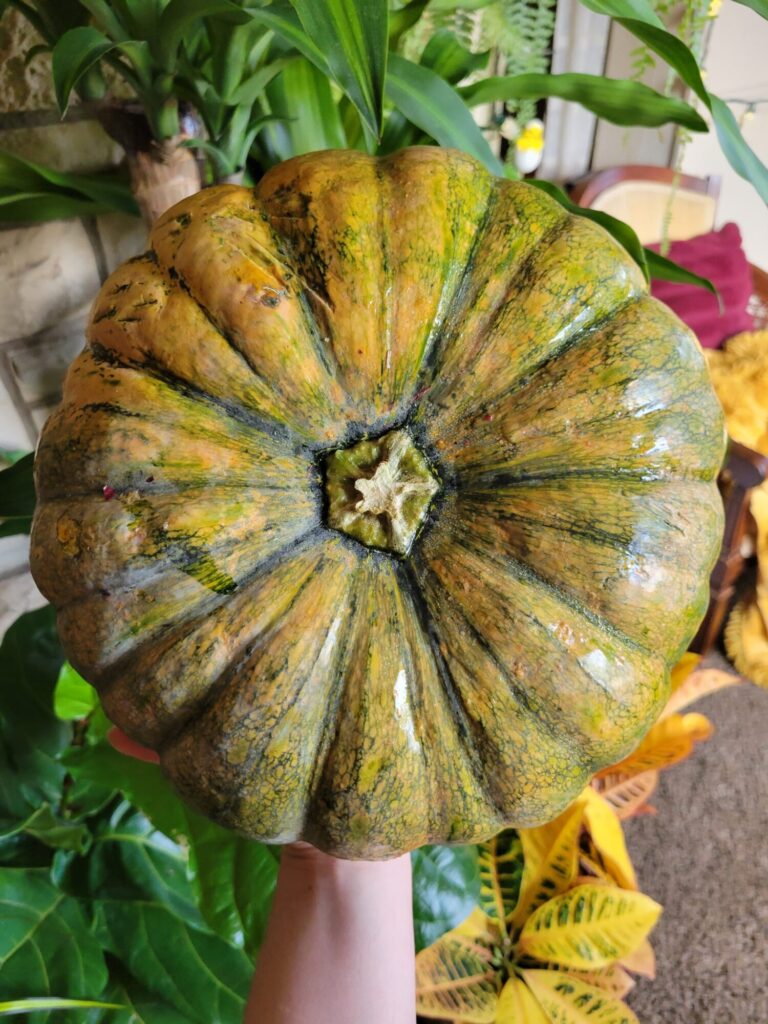
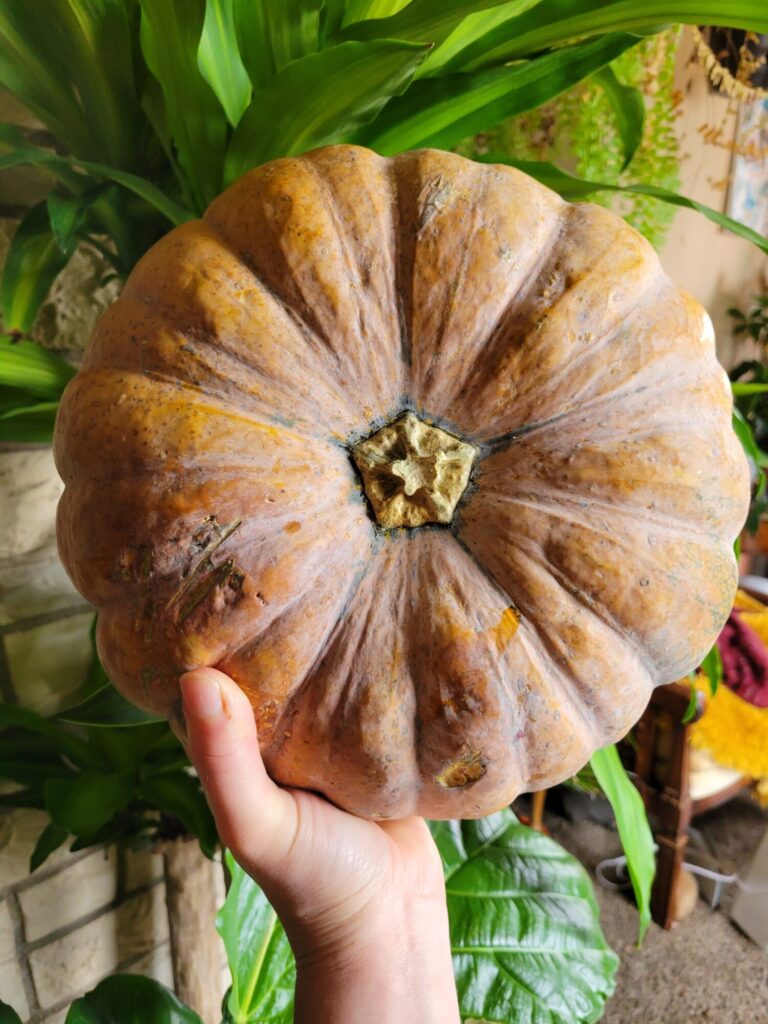
Why Are Some Calabaza Green?
Calabaza will also change color over time. This happens with a lot of produce. Most varieties of peppers and tomatoes start out as green and then turn red over time. It's why green bell peppers are typically less expensive than orange or red bell peppers. They don't need as much time to ripen, so they're overall less expensive and less resource intensive to produce. So, that savings is passed on to customers. They're also less ripe and tend to have a slightly more bitter flavor than their sweeter counterparts.
Whether this is the same way with calabaza squash? I have absolutely no idea! Calabaza squash tend to weigh about 10 pounds. So, buying a green-tinted one and a deeper orange one and comparing them side by side is not exactly practical! Although I wouldn't be surprised if they get a greater depth of flavor with longer ripening times, I probably wouldn't assume that it makes much of a difference. If you closed your eyes and had to guess whether there were red or green peppers on your pizza? I doubt that many people would notice or really care.
The above pictures are of the exact same squash taken two and a half weeks apart.
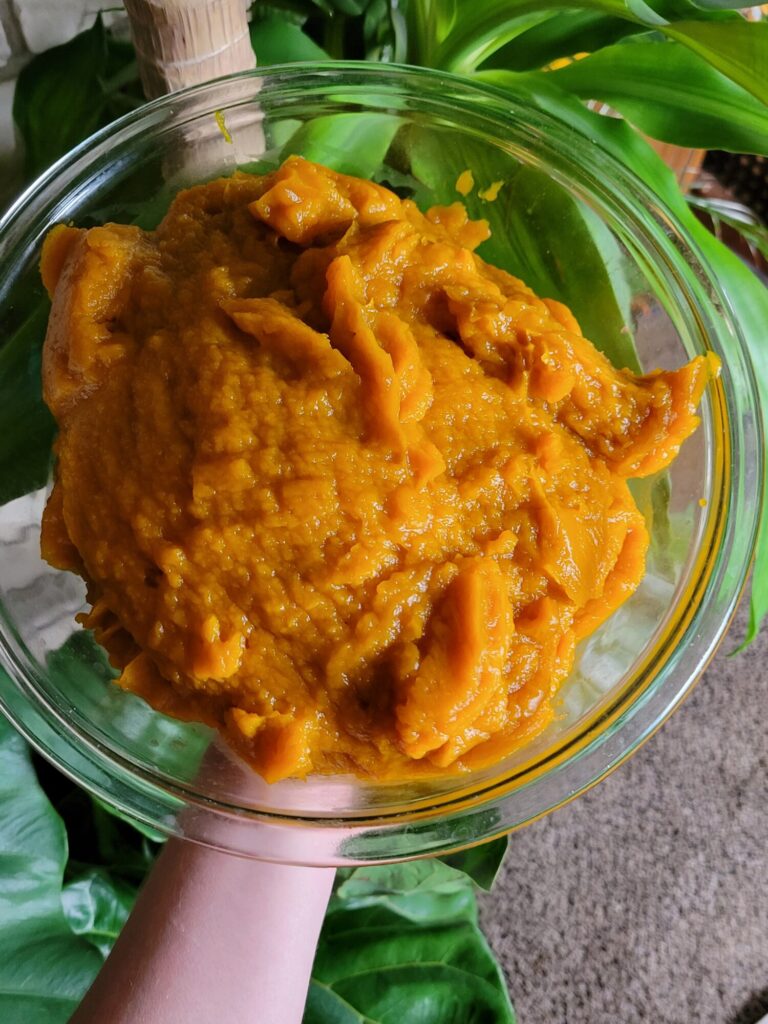
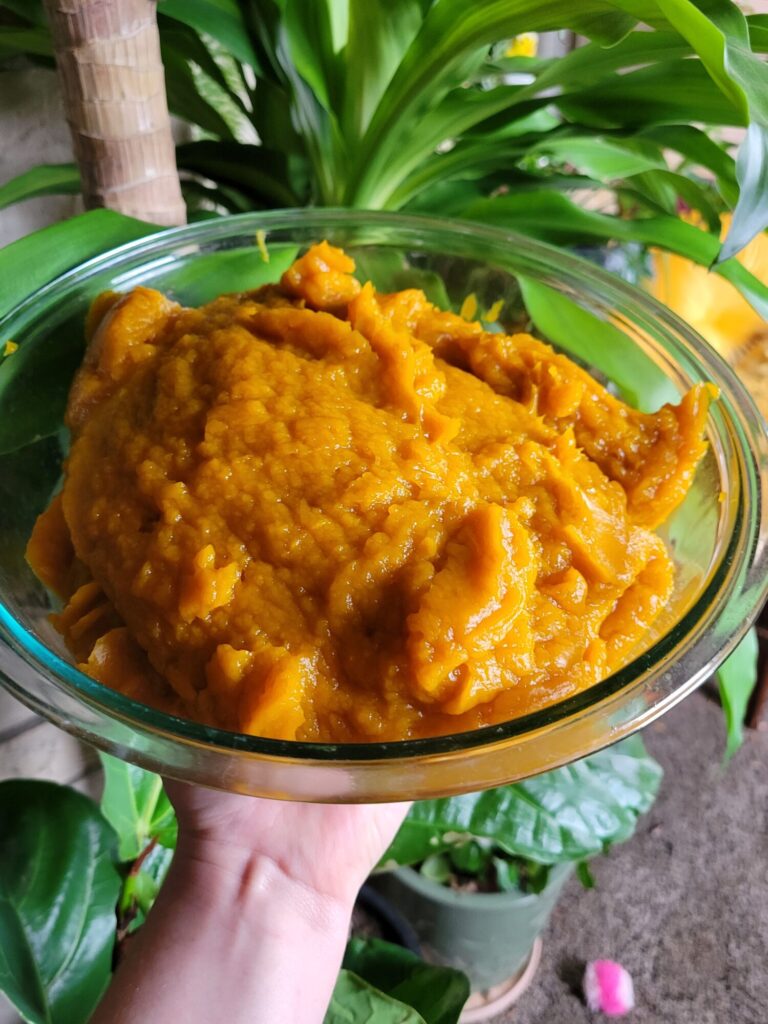
Is Calabaza REALLY that Orange?
I tend not to edit my photos at all. I try to make sure that I take pictures in good lighting (preferably natural lighting, but I do cook at night sometimes when it’s dark and my kitchen has 0 windows, so even on the sunniest of days I sometimes need some help!).
But my camera is having such a hard time taking pictures of this squash!! It’s soooooooo orange. I got turmeric for calabaza curry and contemplated not using it because the squash was already so bright! I kid you not. This thing is practically fluorescent.
I imagined calabaza being a similar color to a pie pumpkin or butternut squash. There is absolutely no comparison. This is brighter than an orange. It’s about the color of a ripe habanero or a dark orange crayon. You could probably dye clothes in the amount of natural coloring present in this fruit. I’ve just been standing in awe of it. It’s rare that you see anything roasted that retains its color so much!
It's important to note that calabaza also range in color from a deep green to a rusty orange. These are merely differing levels of ripeness, but have little-to-no bearing on the color of the flesh.
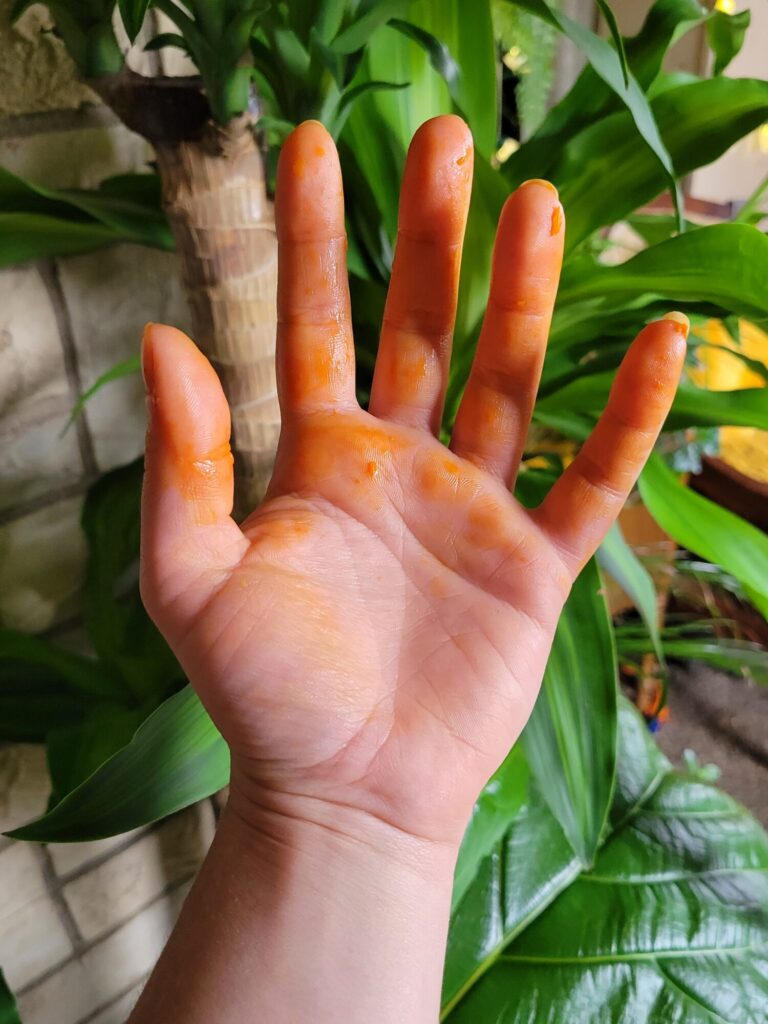

Will It Dye Your Fingers?
Yes, yes it will. Calabaza will dye your fingers orange. Not nearly as bad as turmeric will and it will mostly wash off! But it will dye your fingers to some extent. As well as your clothes, carpet, countertops, and kitten feet. I never recommend cooking in anything that you're worried about getting dyed the color of food or covered in oil stains. Which absolutely NEVER come out!
In that sense, I'm not overly worried about calabaza. However, if you do catch yourself attempting to cook in white or in delicate fabrics? Maybe don't attempt it with roasted calabaza squash.
Although if you'd like to see something that I fear to the Nth degree because, no matter how much you try, it is absolutely going to destroy something that you love and care about because they literally use it to dye other foods and clothing items bright freaking orange? Turmeric.
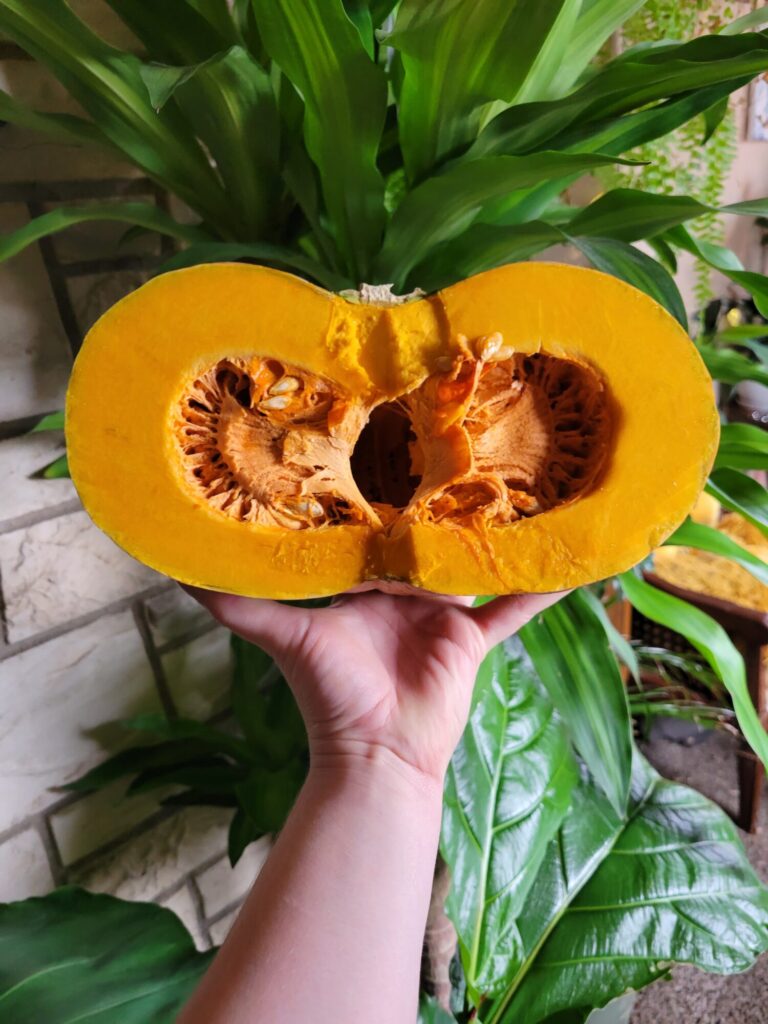
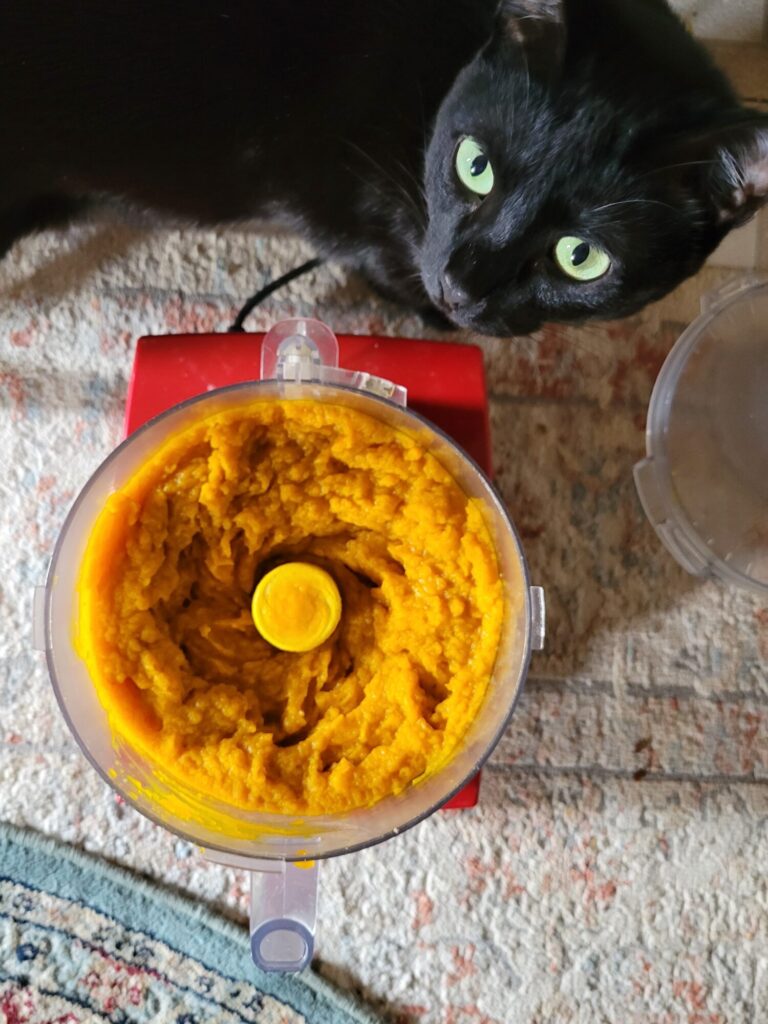
What Does Calabaza Squash Taste Like?
Calabaza squash tastes much like a more robust butternut squash or an elevated sweet potato. The flavor is rich and smooth with a sweetness that's incredibly decadent. The consistency of the purée is almost that of a perfect custard ice cream. I absolutely adore it!
With almost 10 pounds of this squash, I've been trying to figure out what to do with all of it. I went in with the intention of making curry. I'll have more than enough to make several curries, if I please! And intend on making a spicy curry with habaneros from my garden. Upon actually tasting the calabaza purée, my next thought was that it would be absolutely delicious in sweets, particularly with chocolate. Perhaps a fudge or mouse.
The sky is the limit, though! And calabaza is a great substitute for any number of other squash. I've heard that it's the squash of choice when substituting butternut and other more Western varieties. So, maybe it's only fitting that our first foray into calabaza is in anticipation of a Thai-style curry!
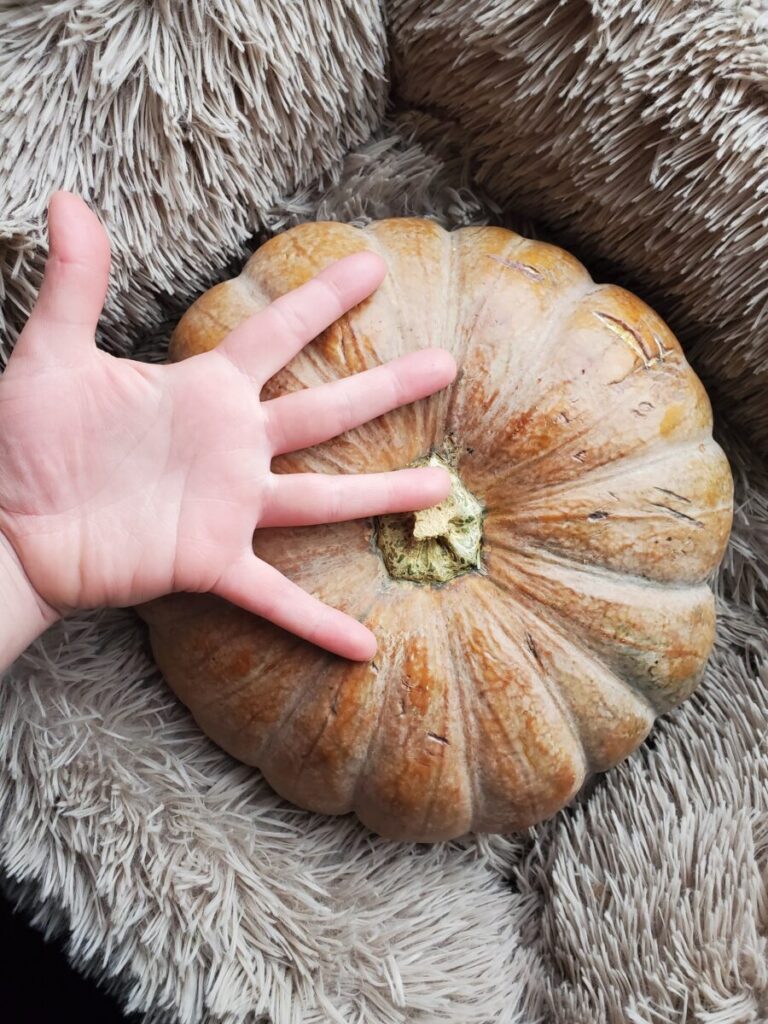
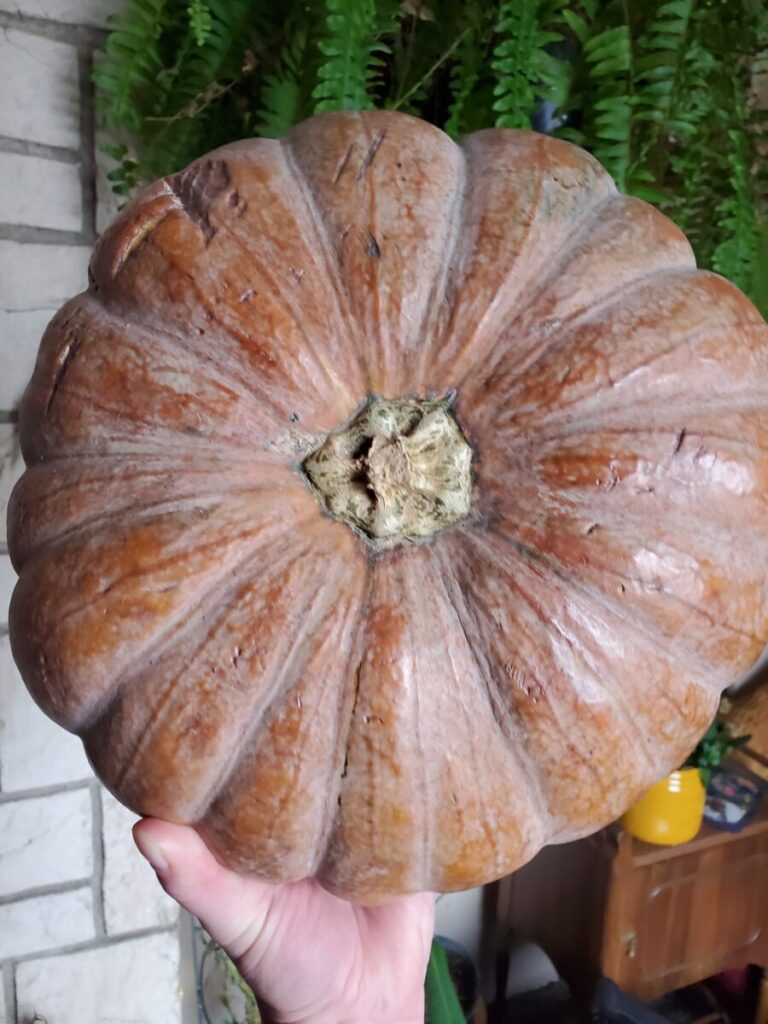

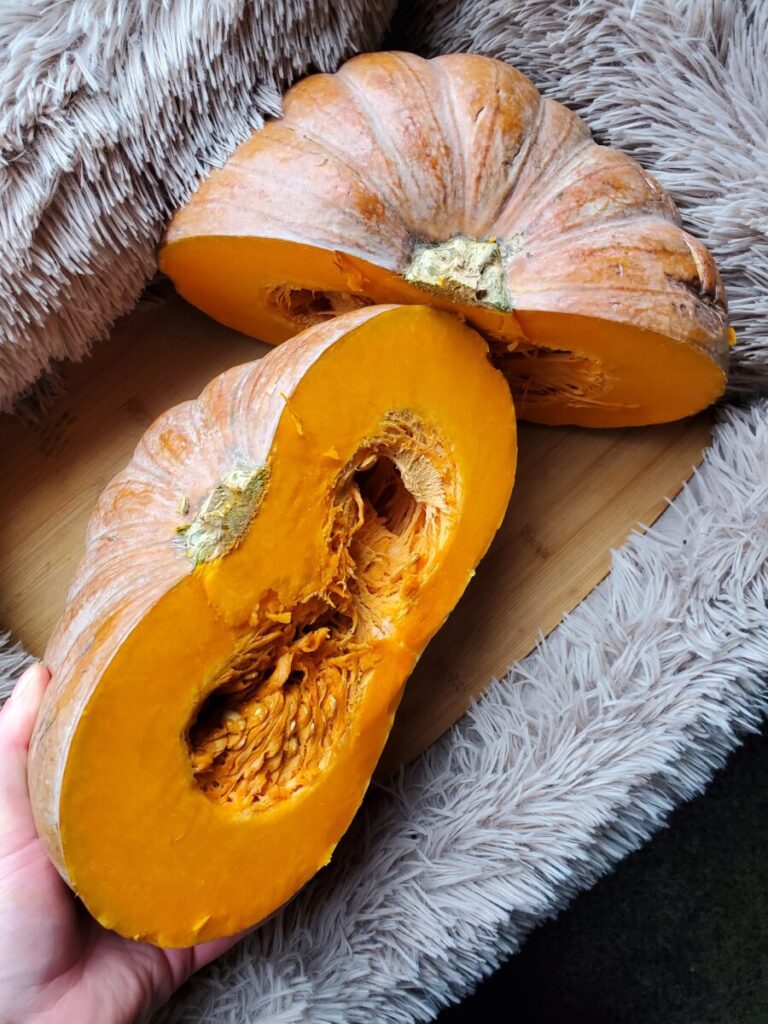
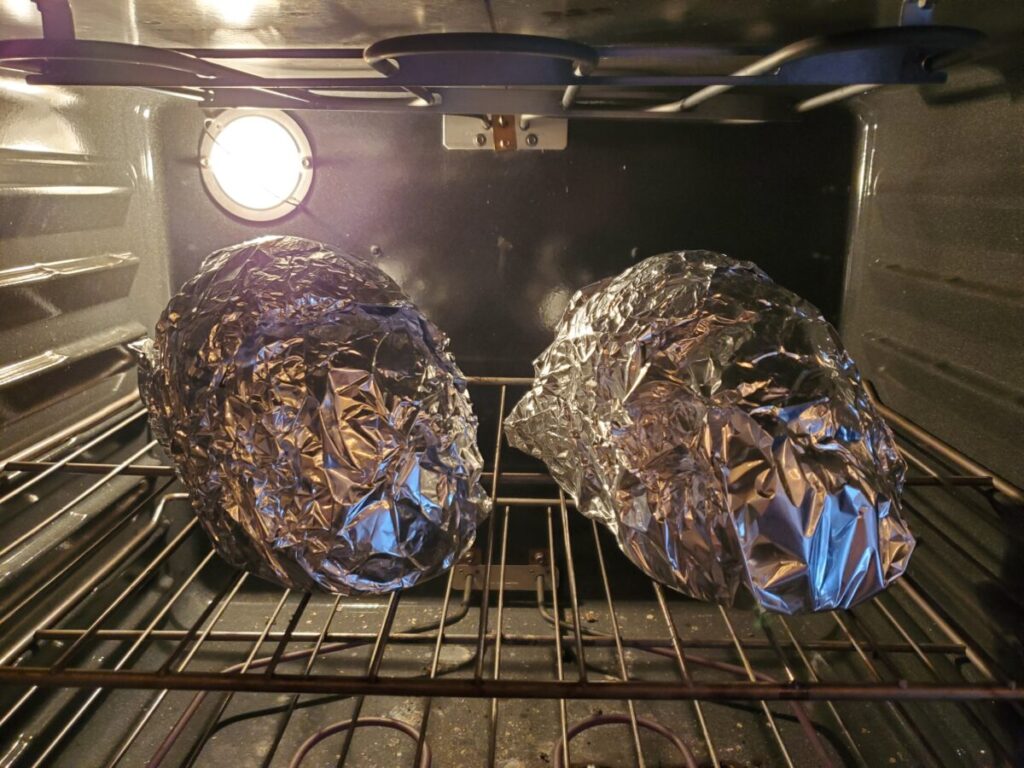
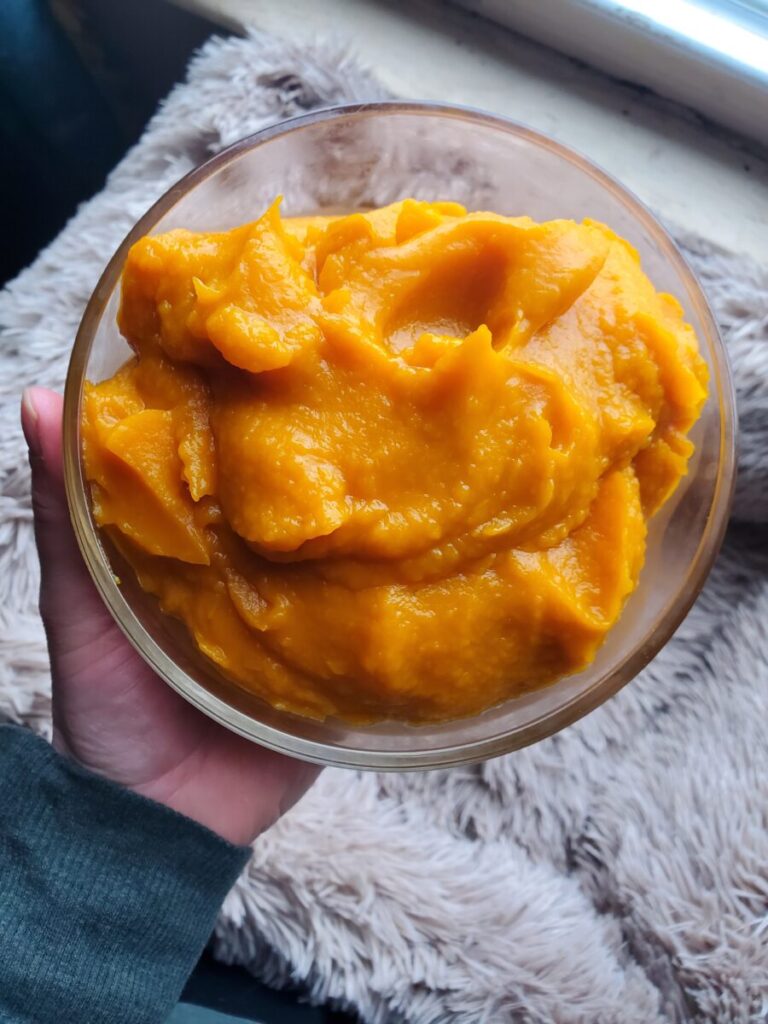
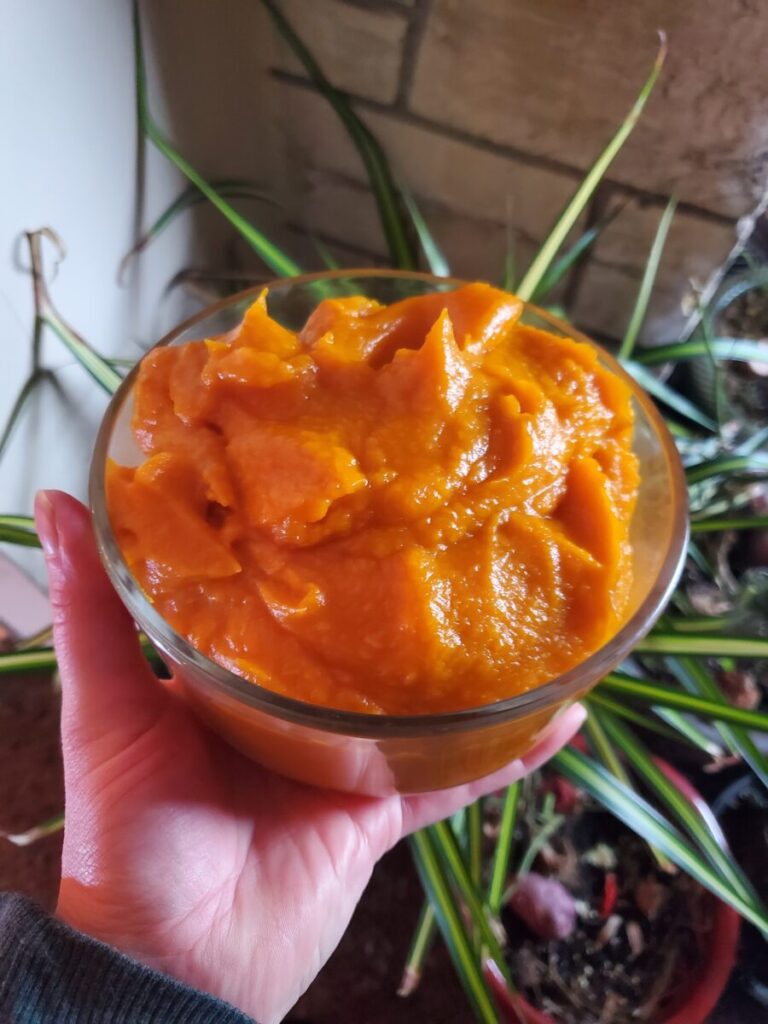


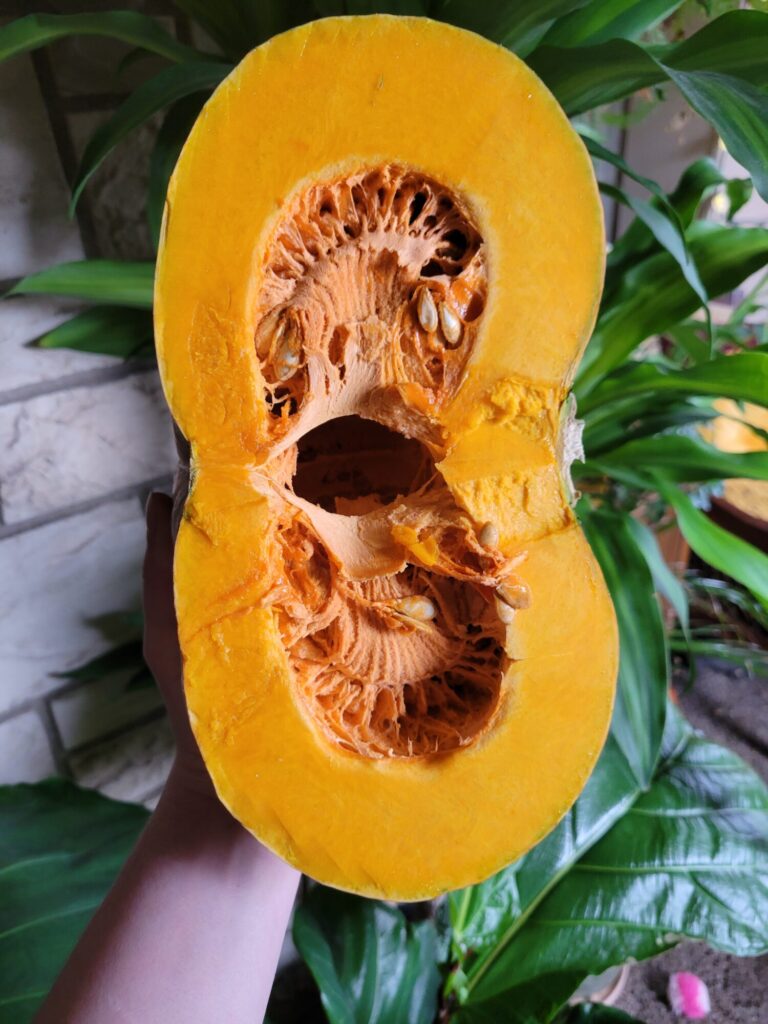
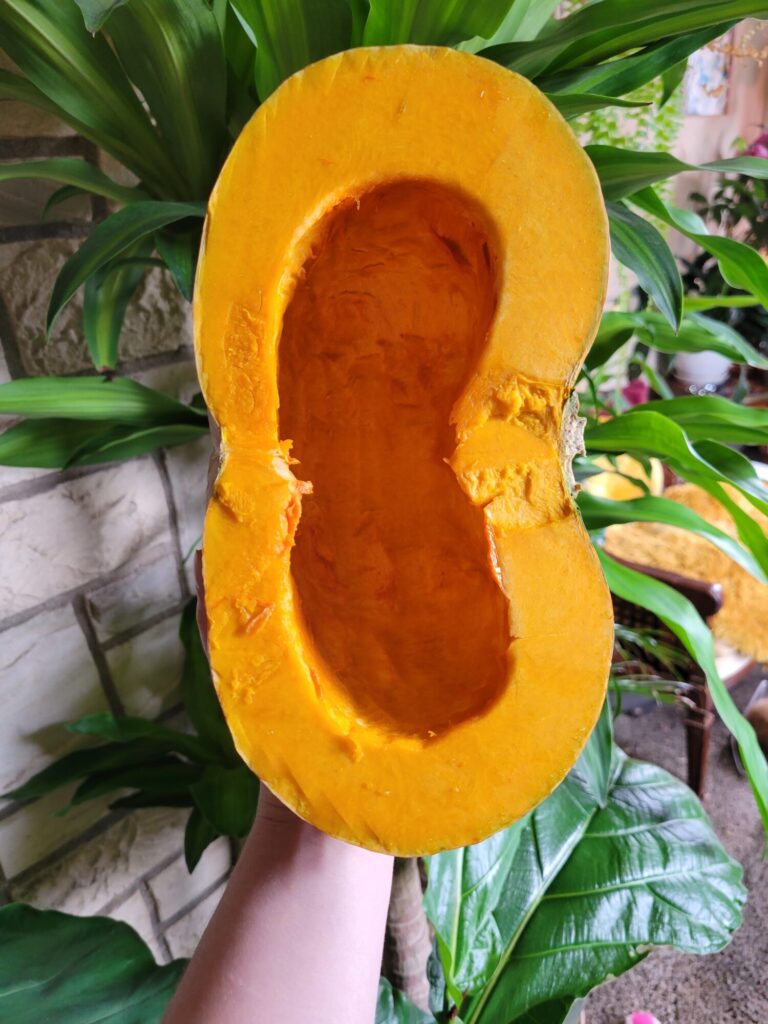
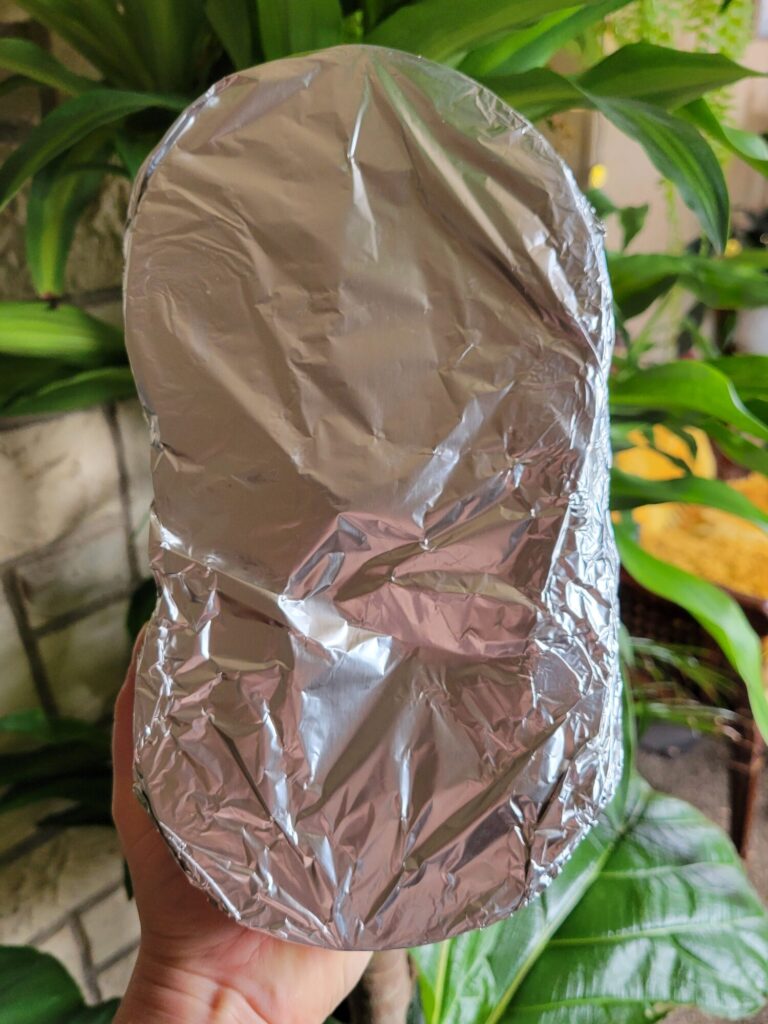
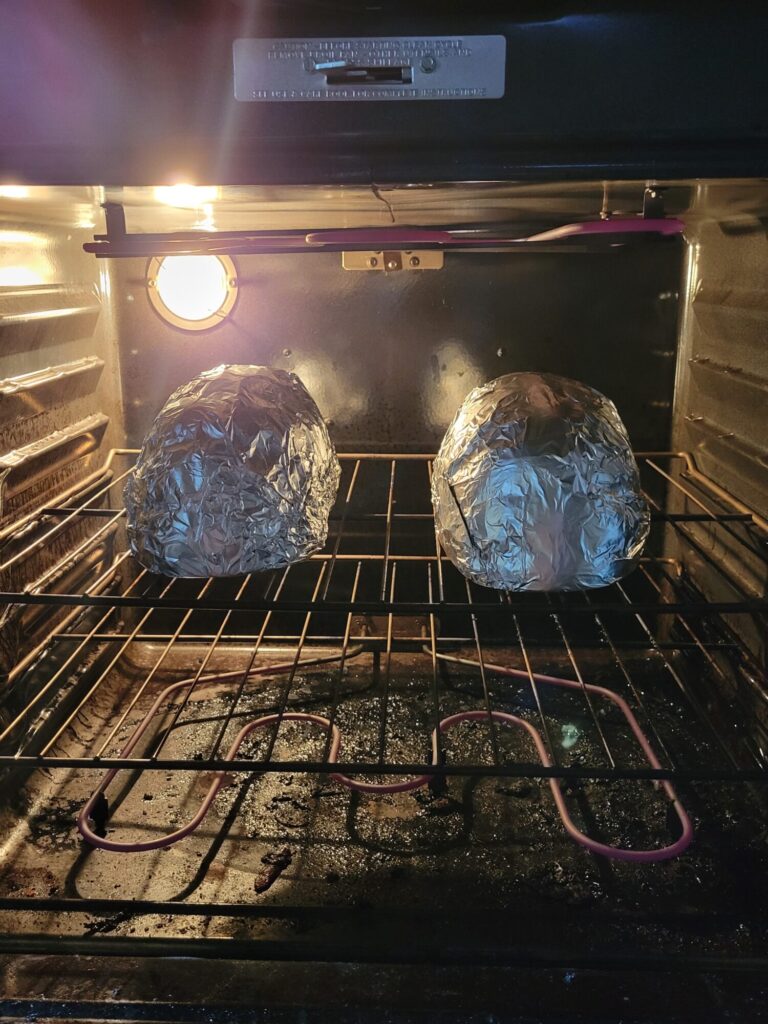
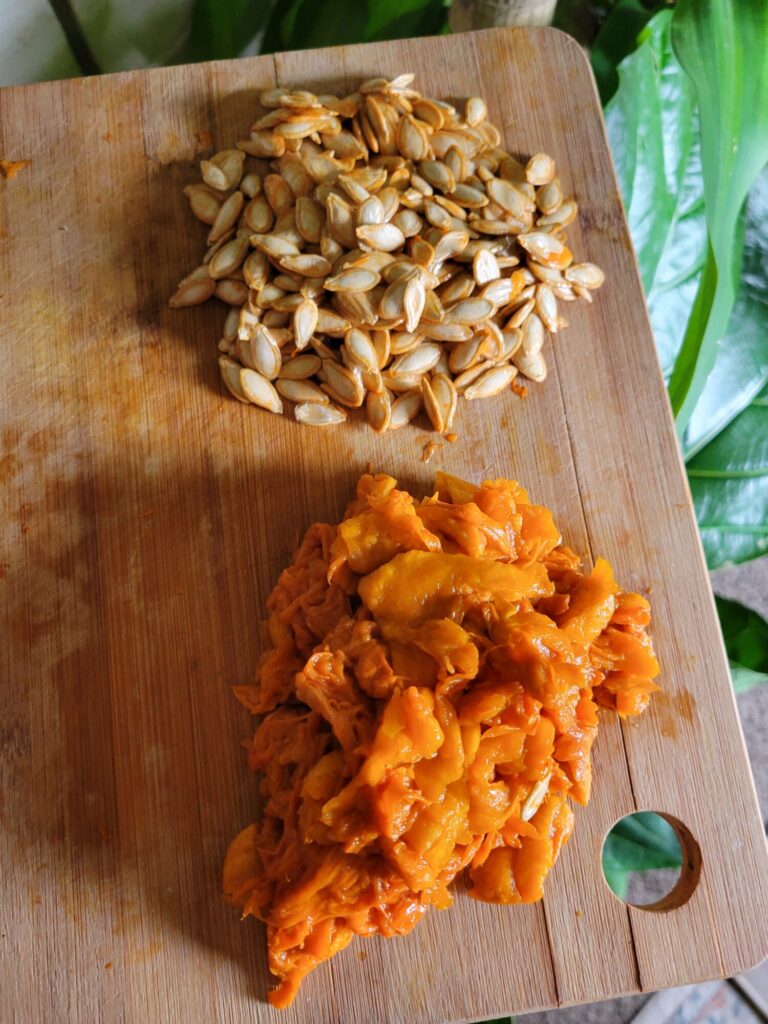
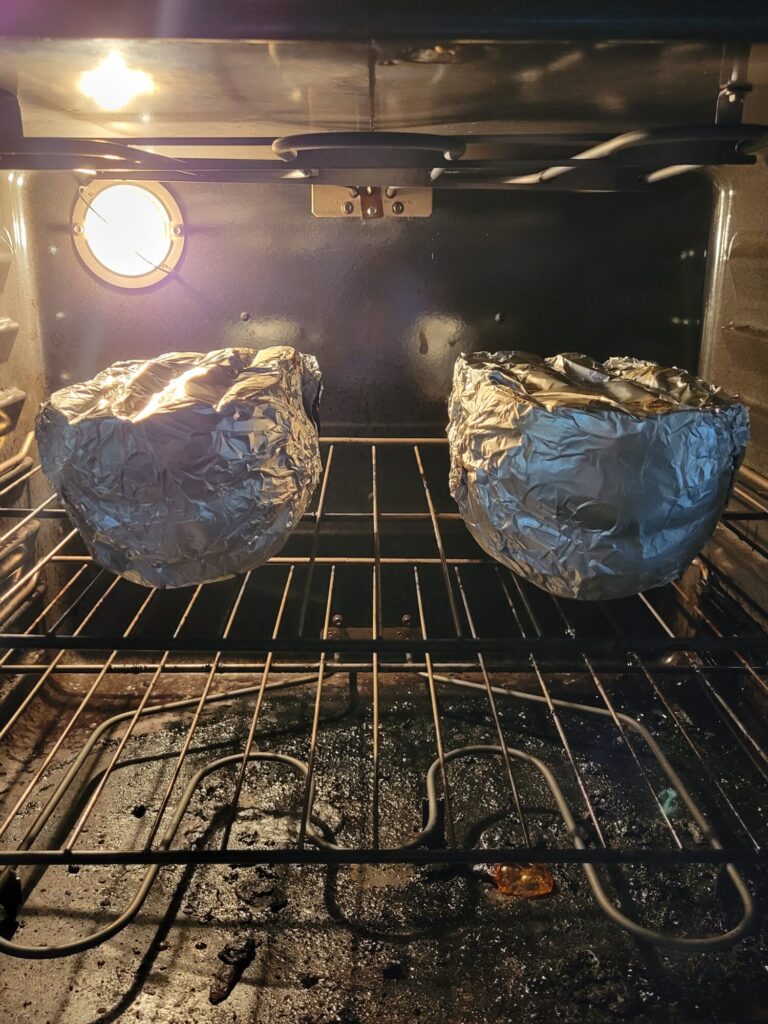

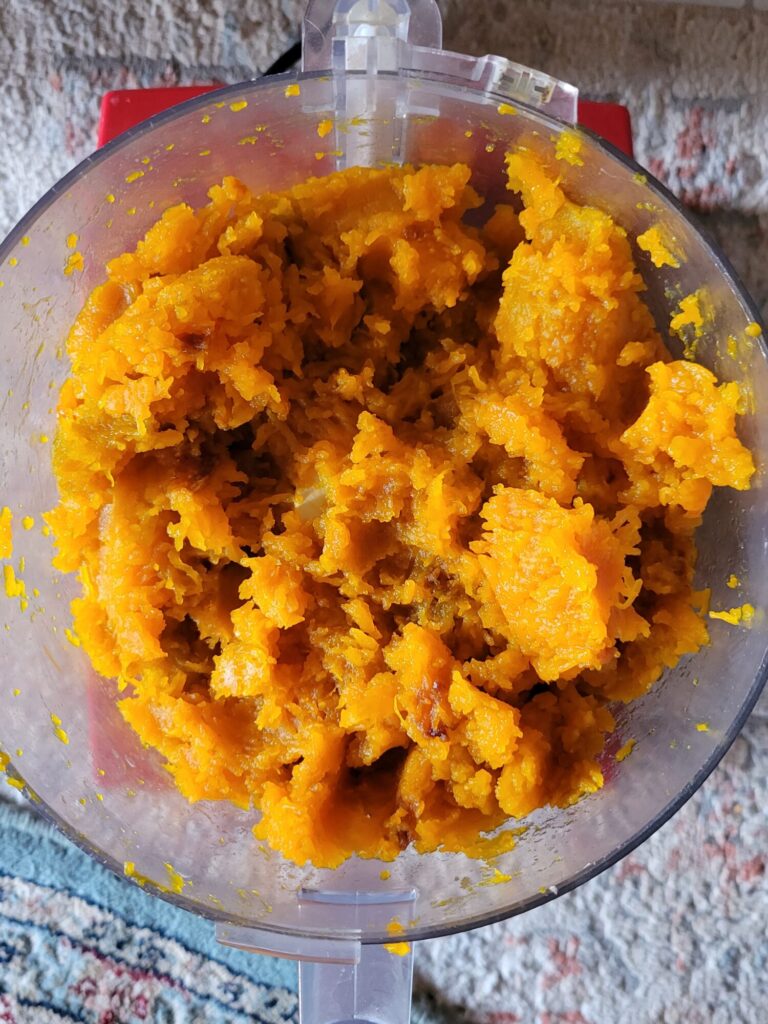

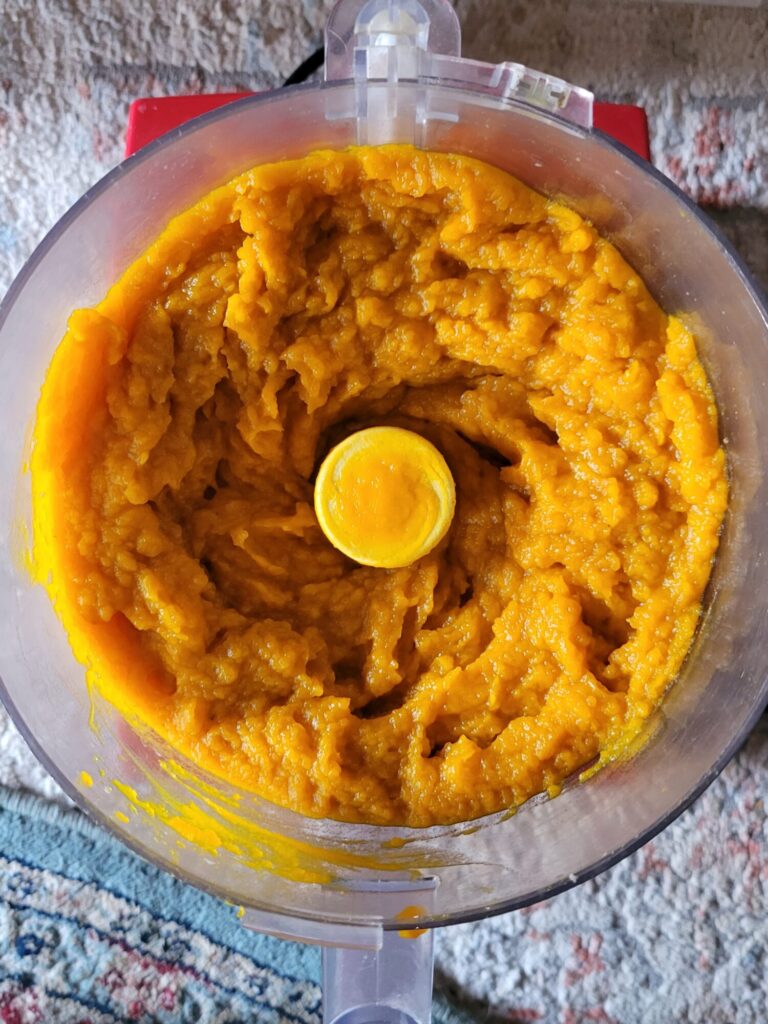
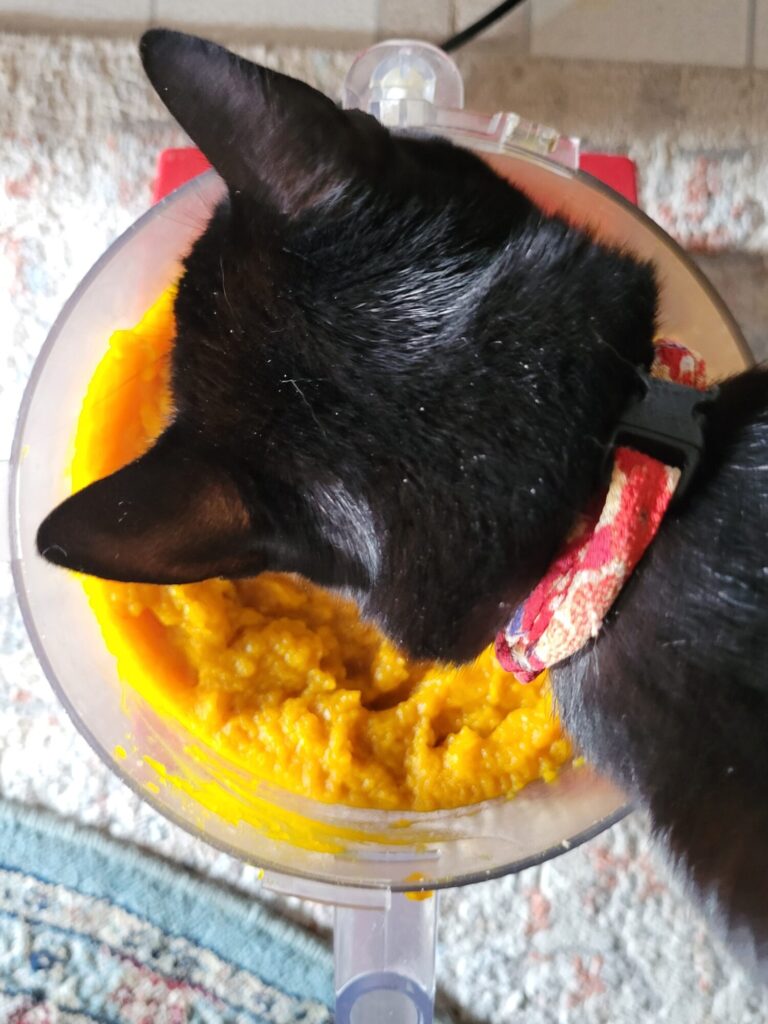
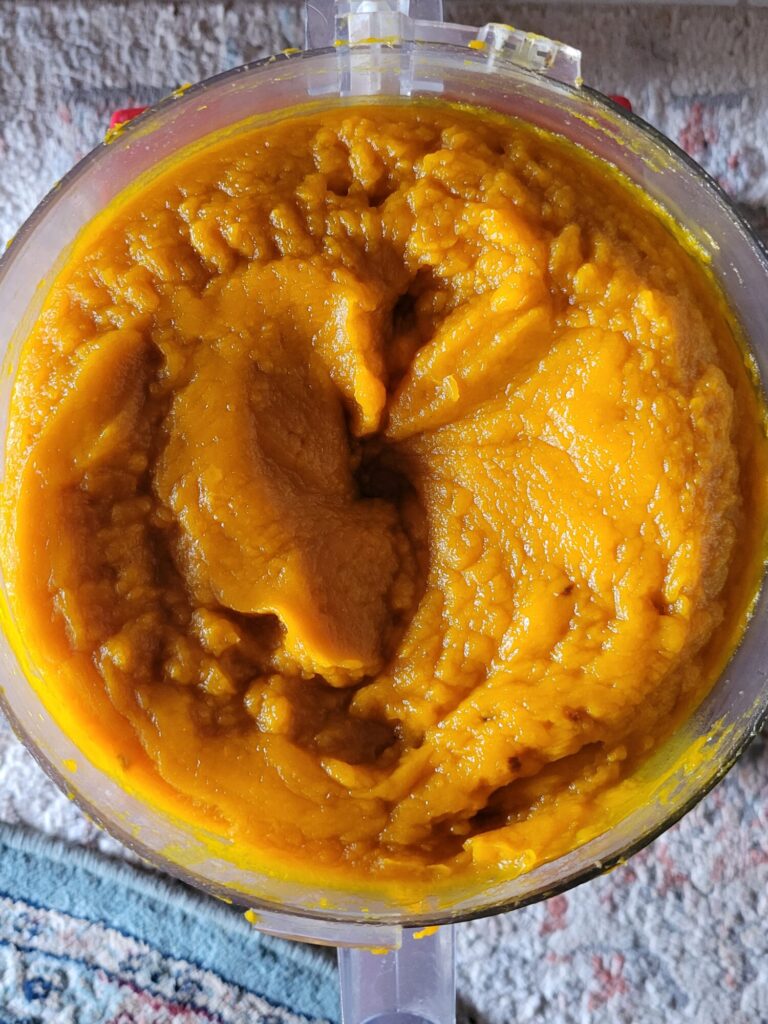
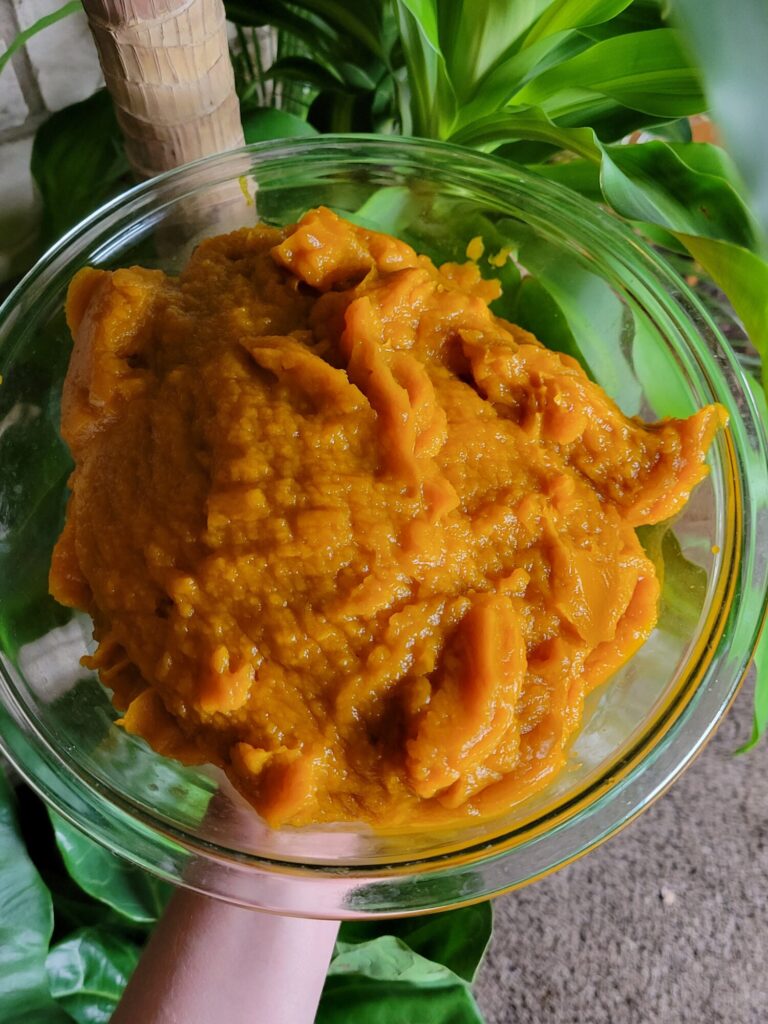
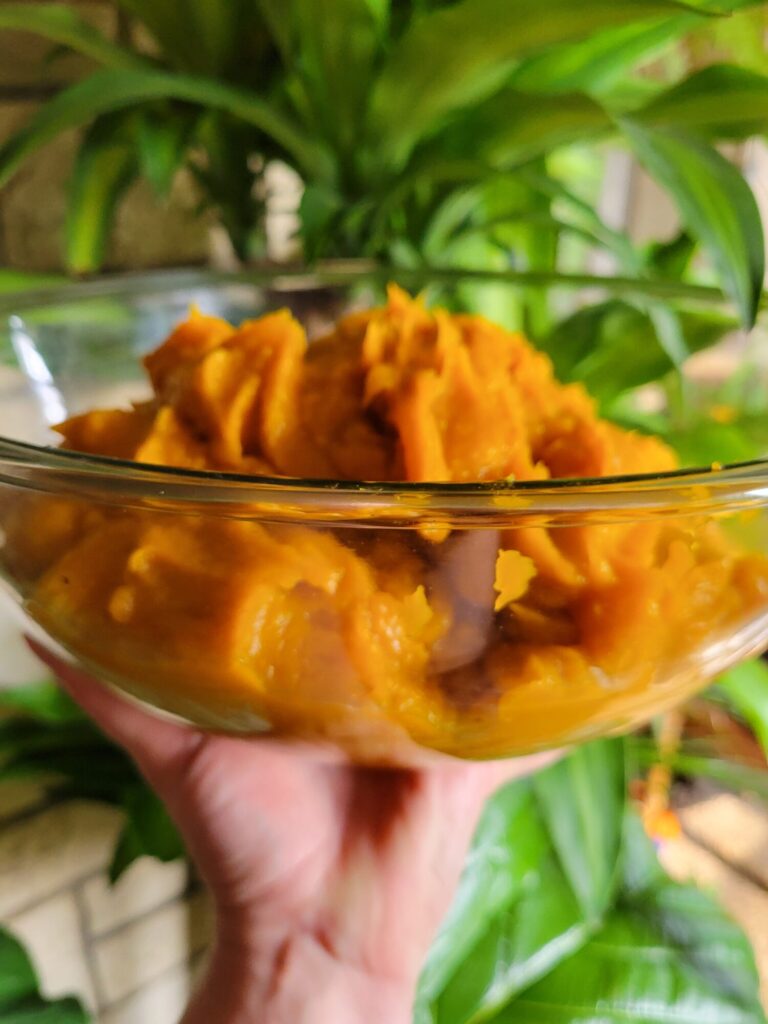
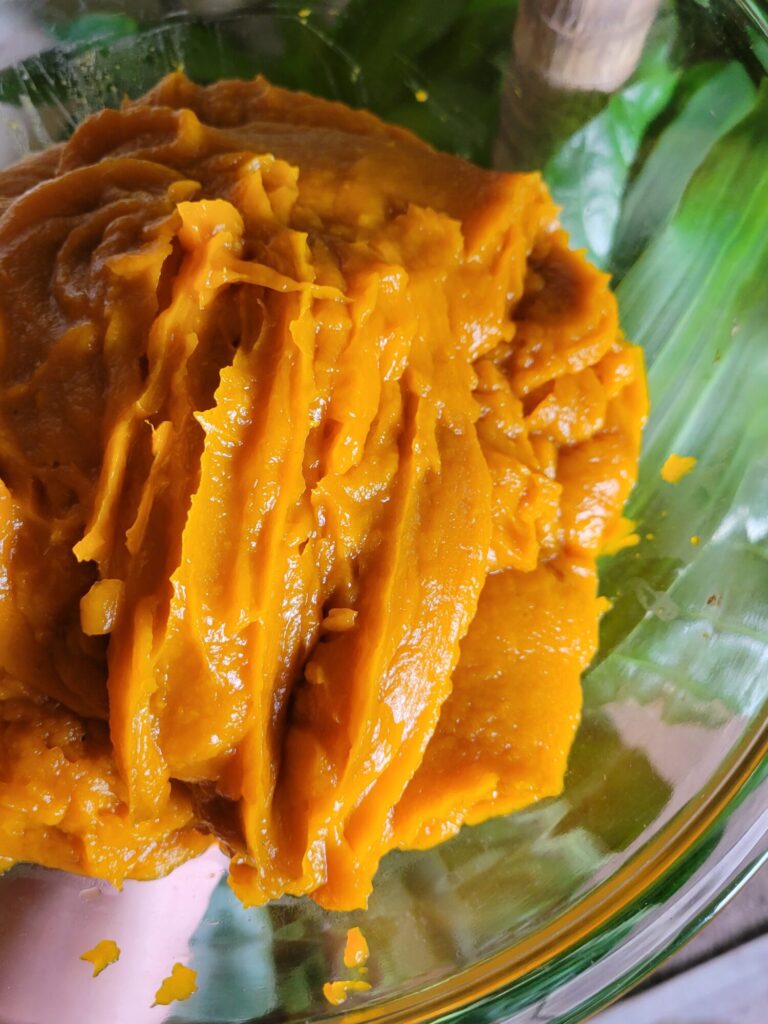


Calabaza weigh about 10 pounds each. Ten pounds of squash will NOT fit in a food processor all at once! It has to be puréed in 2 batches. So, none of these photos represent exactly how much squash that you end up with. The final photos are close. But even that batch is missing about a cup and a half that went into Slow Cooker Black Beans to make room in the food processor.
What to Make w/ Roasted Calabaza Squash
Some of the things that I've delved into in my newfound calabaza squash obsession include several varieties of curry and burritos as well as, of course, roasting the seeds! Which no squash should ever be roasted without. There is also a full list of everything that I used this Calabaza Squash in.
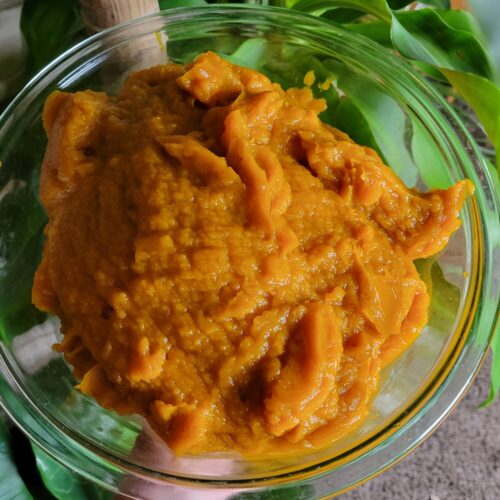
The Fundamentals of Roasted Calabaza Squash
Equipment
- Oven
- Baking Sheet
- Aluminum Foil
- Oven
- Food Processor
Ingredients
- 1 calabaza (or similarly large squash or pumpkin)
Instructions
- Preheat oven to 450 degrees Fahrenheit.
- Cut squash in half.
- Using a spoon, scoop out the innards to remove all of the seeds and stringy pieces. Reserve the seeds if you want to roast them for a fun snack.The "guts" are still edible, but can be texturally unpleasant. I will usually keep them to puree into soup or pet food. However, most people will discard them! Just make sure not to toss any seeds!
- Once you've cut in half and removed the innards from the squash, wrap in aluminum foil. You can also place this on a baking sheet if you want to keep any of the juice from seeping through the foil.I do this by getting a piece of foil long enough to wrap around the entire squash. Place squash face down in the center of the foil. Then, wrap the edges of the foil around to cover the squash completely.I didn't do this, but would highly recommend cutting the squash into fourths, instead of just halves! This would decrease the rather long cooking time for something this size.
- Bake for 2 - 3 hours depending on size. Make sure to flip halfway through so that the squash sides are face up.This is the trickiest part about roasting squash: the size of the squash can drastically increase the cook time. You’ll know that they’re done when the flesh is soft and you can poke it with a fork without any resistance. It will vaguely resemble the consistency of potatoes before you mash them. The best thing to do is to cook them for an hour and then check them every 20 minutes after that until they’re cooked throughout.
- Let cool to the touch.You can also put the squash in the refrigerator or freezer to speed up this process. Just place it in a heat-safe bowl and place an oven mitt in between the bowl and any glass shelves. As the rapid change in temperature can crack and break.
- Remove skin and add squash to the food processor. It should peel off easily. If you like, you can get every bit of pumpkin out of it by scooping the remaining pumpkin out with a spoon.
- Purée until smooth, about 2 minutes. Make sure to scrape down the sides occasionally.
Tips, Tricks, & Notes
- This also took absolutely forever to cook! In hindsight, that was pretty obvious. It is rather enormous! I would absolutely encourage you to cut it into quarters, rather than trying to roast in halves. The edges are definitely softer than the center. But it did work out. It just took a couple of hours…
- This is also A LOT of purée to make all at once. Particularly because squash doesn't tend to keep that well over time. I used about half of it right away for purée and then froze the rest. Purée tends to crystalize and isn't always the best texture after freezing, though! So, I opted instead to freeze the squash whole and then thaw it out and purée later on. This worked remarkably well and I recommend it if you end up with too much squash after roasting!
- For more tips and tricks to roasting squash, I have an entire article on The Fundamentals of How to Roast Pumpkins, Squash, & Other Gourds. This article more specifically pertains to the differences in varieties and my go-to recipe for smaller ones, like butternut squash and pie pumpkins.
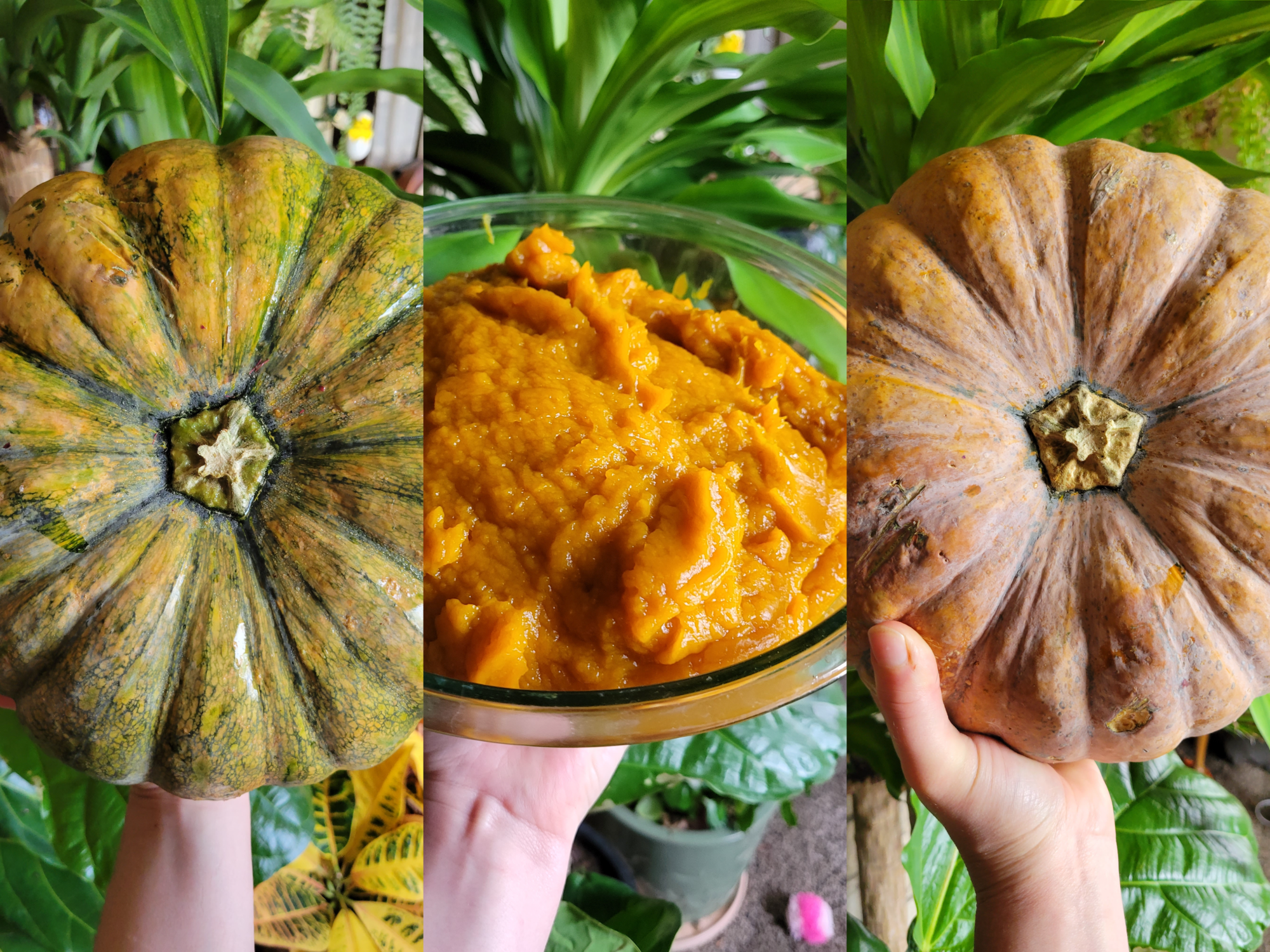
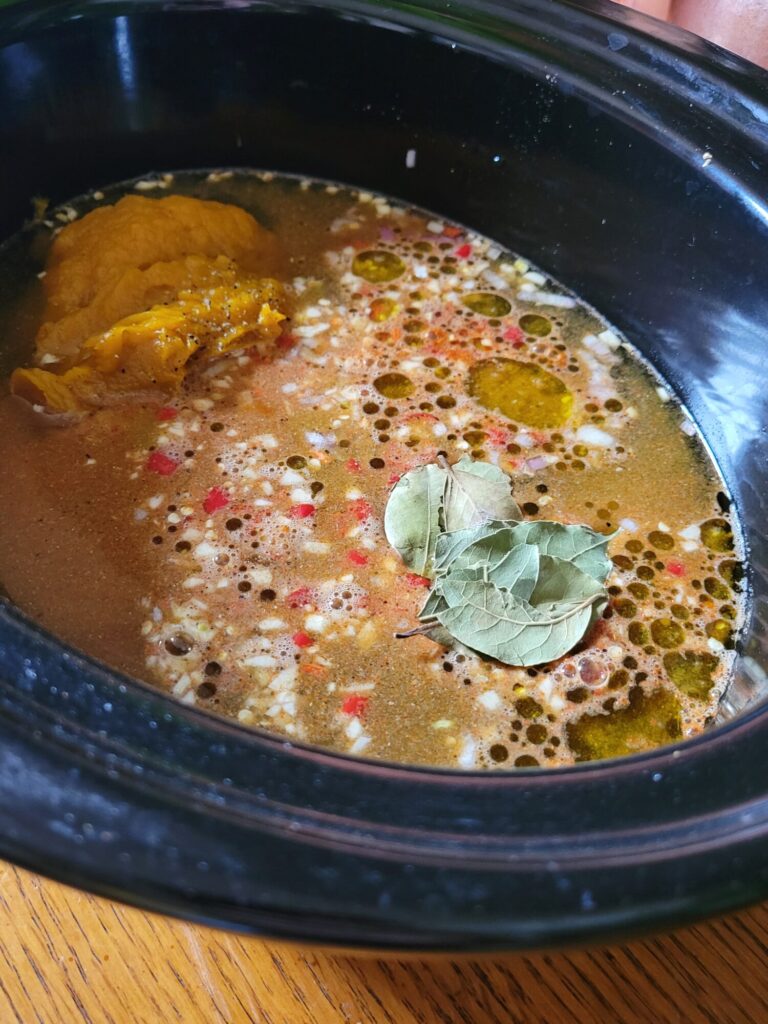


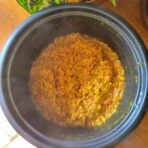

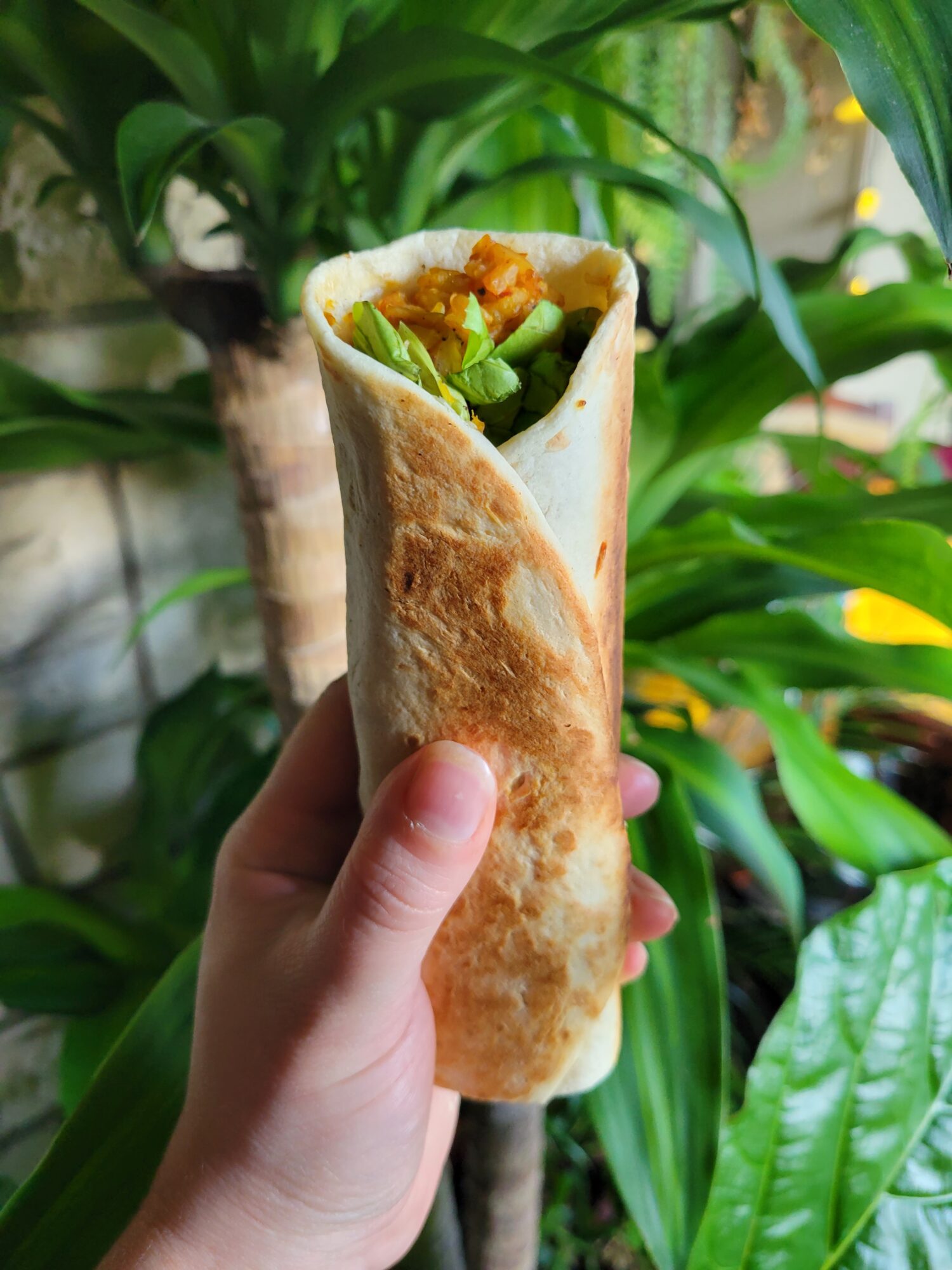
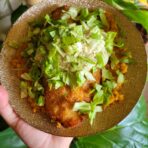

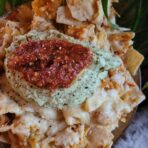

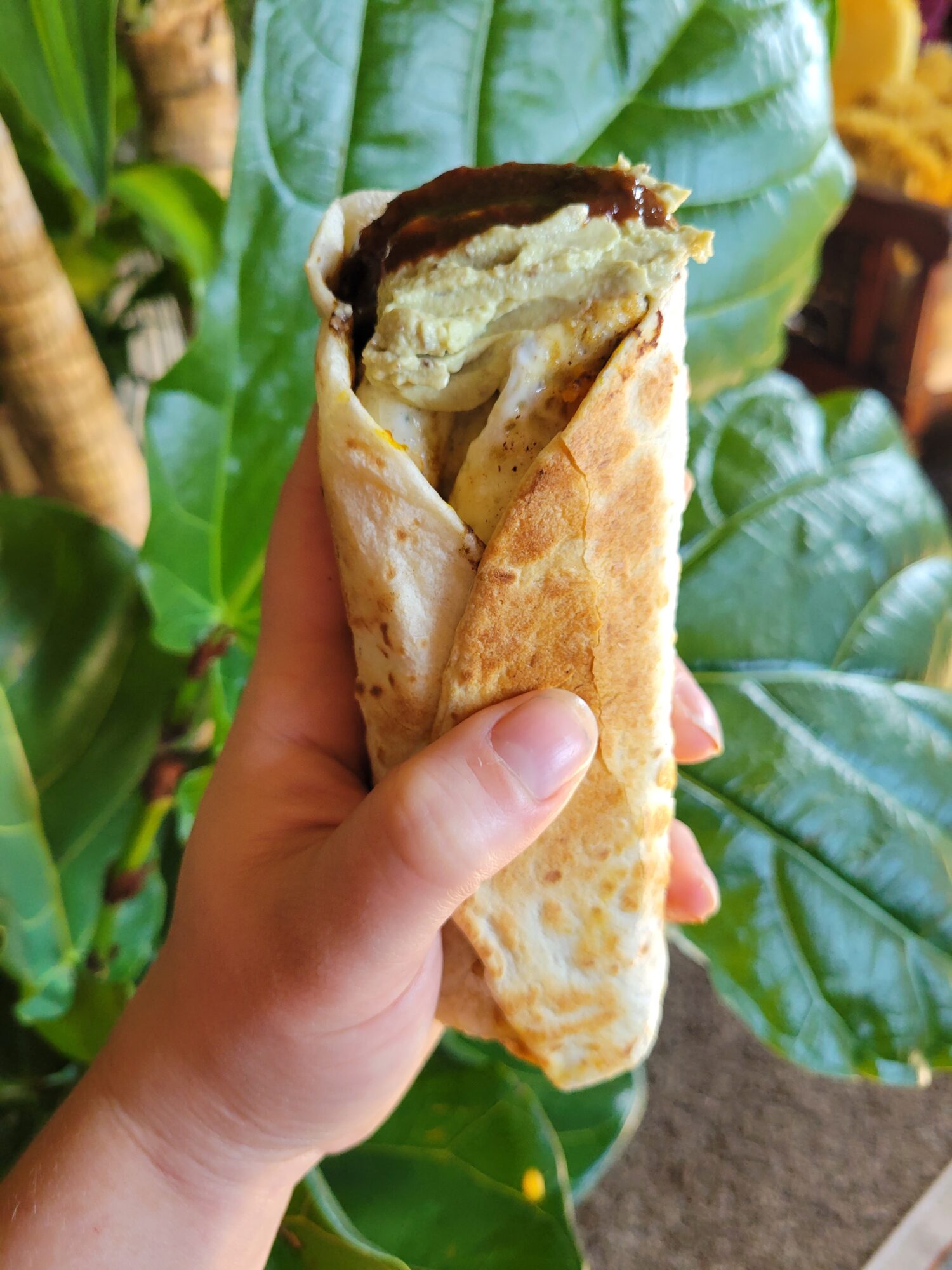
Janice
April 21, 2022 at 2:51 pmSubstitute equal amounts for your favorite pumpkin pie recipe.
Catfish Out of Water
April 27, 2022 at 9:20 amCalabaza squash makes for a really good pumpkin substitute! I use it all of the time. It’s much more flavorful and has a brighter orange hue than pie pumpkins.
Carol Szemiot
December 12, 2022 at 1:26 pmIf you read the label on canned pumpkin, you will see that it is calabaza squash. Perfect in pumpkn pie!
Lorraine Lott
October 28, 2023 at 2:36 pmJust very recently bought calabaza squash. It was so good, I just bought another and it’s almost 8 pounds. Going to cook it now. I just eat it after it cooks, put remainder in a glass bowl and use it, just as it is. Today I put it in a chicken broth with some vegetables for a great soup mainly because I used a lot of real lemon in the broth and it was way too sour. Calabaza to the rescue, soup was delicious! I love calabaza reminds me of a cross between a sweet potato and regular squash, but so much better!